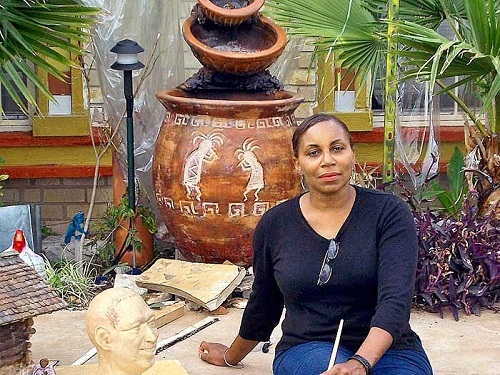 |
| The Jack Johnson Community Park in Galveston, Texas will feature Adrienne Isom’s full-size bronze sculpture of Jack Johnson, the first African-American to win the world heavyweight boxing title. Image via GalvestonDailyNews.com. |
From staff reports
The Galveston Daily News
April 15, 2012
April 15, 2012
GALVESTON — Adrienne Isom, of Austin, completed a life-size statue of Jack Johnson, which will be the focal point of a park honoring the island native who became the first African-American to win the world heavyweight boxing title. Isom, who has twice received a Texas Legislative Commendation for her work, heads Wax Track Gallery International, a nonprofit organization based in Austin and funded in part by the city of Austin Department of Economic Development and Texas Commission on the Arts since 1995, as well as Isom Enterprises, an industrial design and contracting business.
Q: What did you like most about Jack Johnson?
A: He was an extraordinary man. He did such radical things with his life. He was well-read and a man of international intelligence.
He was like few people who dared to challenge what he felt should be everyone’s rights — things that should not be inhibited because of laws and actions that did not reflect our constitution.
Q: You mentioned that photographs show his weight fluctuated quite a bit.
A: Sometimes, he would be heavier than at other times. In studying Jack’s look, I saw he paid more attention to exercise and diet, according to how he valued a challenge of a particular opponent. I think he looked his best right before the world heavyweight bout.
Q: His boxing gloves look small by today’s standards. Did they use less padding back in the day?
A: If you examine the gloves they say were his, those gloves were of the later version and stuffed a bit more with horse hair. I discussed his gloves with quite a few professionals. The gloves you saw him with the most were the slimmer kind. I tossed back and forth on what look he should have physically, as well as the version of gloves he should be wearing before settling on the unstuffed version.
Q: You studied under John T. Biggers, who was a legend at Texas Southern. What did you get most from him?
A: His work ethic. Doc was an international legend. I kept in touch with him from to time. As a young adult, I asked him, “How does an artist become successful?” He replied, “You must work when you have nothing to do. Even when you don’t have a commission, you work.”
I continued every week remembering those words. For everyone, this is what people need to realize if they want to continue to polish their gifts or any profession.
Q: Who are your inspirations?
A: I was, and am, inspired my deceased father, Alton D. Rison, former principal (first, a history teacher for more than eight years), a national education curriculum specialist and playwright, who was a very busy professional but was equally a busy father who took great time to take me, along with my other two sisters, to every cultural event and historical site of any culture he could fill our time with. This helps me to have a maturity of understanding in how I see the world, enabling me also to go beyond many mental barriers in conducting business.
Q: Tell us about how you work.
A: I live in one room — the entire house is work space. I got this concept from an Asian woman here. I was creating a design for the Philippine American Society. When I went into her home and walked inside, I saw the living room was a business. The den was lined up with sewing machines where they made bulletproof vests. There was another room with another business.
I said to myself, “Now this is how you use space!”
People sit around dreaming and suffering financially all of the time in America. Many say they do not have enough money to open a business but have homes with rooms and garages.
They fill up the space with furniture to entertain a few friends five or six times a year.
After visiting that lady, I spent my following years visiting my concept of what is the real importance of space and what was important to me. I got rid of a 6,000-square-foot studio I was renting, my living room furniture and other bedroom furniture.
Now, I use every inch of my living space, with the exception of my bedroom, which is off limits to sculpting and business projects.
The only other room that is not subject for a project is my workout room.
It is important.
Eventually, I built a two-story shop in the rear of my property, but it seems I never use it much.
Q: Why is the workout room important?
A: To do this type of work, you must stay in shape, having some sort of exercise program and keeping corrosive foods and drinks out of your body.
In this business, I am always up for question and asked subtlety by nearly everyone, “Where is the man who does this?”
When I say I am the sculptress or industrial artist, they just look and stare. You can see in their eyes they are thinking: “Well, that looks like really hard work. She does not look like she could do that.”
People also need to know that whatever they do takes preparation, such as physical training and quality time spent thinking and researching their goals. It’s not just for football players.
What you do must become a part of who you are to master it. My profession is my sport, my entertainment and my friend.
 |
| Adrienne Isom. Image via GalvestonDailyNews.com |
No comments:
Post a Comment